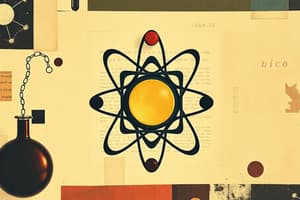Podcast
Questions and Answers
What is matter composed of?
What is matter composed of?
Chemical elements
What determines the atomic number of an atom?
What determines the atomic number of an atom?
The number of protons
What are isotopes?
What are isotopes?
Atoms of the same element with different atomic mass numbers
Which type of bonds are most common in minerals?
Which type of bonds are most common in minerals?
All minerals are man-made substances.
All minerals are man-made substances.
What is the basic building block of all silicate minerals?
What is the basic building block of all silicate minerals?
Which of the following minerals contains the carbonate radical?
Which of the following minerals contains the carbonate radical?
Match the following definitions with their terms:
Match the following definitions with their terms:
What is the definition of a rock?
What is the definition of a rock?
What processes account for the origin of minerals?
What processes account for the origin of minerals?
Flashcards are hidden until you start studying
Study Notes
Composition of Matter
- Matter consists of chemical elements, made up of atoms.
- Atoms contain protons and neutrons in the nucleus, with electrons orbiting in electron shells.
- The atomic number is defined by the number of protons in the nucleus.
- Atomic mass number is the total of protons and neutrons.
- Isotopes are atoms of the same element with varying numbers of neutrons.
Bonding and Compounds
- Atoms bond to form compounds, commonly through ionic and covalent bonds.
- Minerals, primarily compounds, typically exhibit crystalline structures.
- Metallic and van der Waals bonds are also present in some minerals.
Mineral Characteristics
- Minerals are naturally occurring, inorganic, crystalline solids with specific chemical compositions.
- Importance of natural occurrence excludes human-made substances (e.g., synthetic diamonds).
- A mineral’s composition is represented by a chemical formula (e.g., SiO₂ for quartz).
Silicate Minerals
- Over 5000 minerals are identified, with most being silicates.
- The silica tetrahedron (one silicon atom, four oxygen atoms) is the basic building block of silicates.
- Silica tetrahedra cannot exist as isolated ions due to their negative charge; they bond with positively charged ions.
Types of Silicates
- Silicates are categorized into ferromagnesian (containing iron or magnesium) and nonferromagnesian.
- Carbonate minerals contain the carbonate radical; common examples include calcite and aragonite.
Other Mineral Classes
- Other recognized mineral classes include hydroxides, oxides, phosphates, halides, sulfates, and sulfides.
- Luster is categorized as metallic or nonmetallic, with some minerals lacking distinct crystal forms.
Mineral Properties
- Cleavage is defined by quality, direction, and angles of cleavage planes. Fracture refers to irregular breakage.
- Relative hardness is assessed using the Mohs hardness scale.
- Specific gravity is the weight ratio of a mineral to an equal volume of pure water at 4°C, while density is mass per unit volume (grams/cm³).
Rocks and Rock-Forming Minerals
- A rock is an aggregate of one or more minerals or mineral-like/fossilized matter.
- Rock-forming minerals, chiefly silicates, are crucial for identifying and classifying rocks.
Formation and Economic Resources
- Minerals originate from various processes: cooling magma, weathering, seawater evaporation, metamorphism, and biogenic processes.
- Economic minerals/resources are classified as metallic, nonmetallic, and energy resources.
- Reserves are known mineral resources that can be profitably extracted influenced by market conditions and technological advancements.
- The U.S. relies on imported resources to sustain industrial activities.
Studying That Suits You
Use AI to generate personalized quizzes and flashcards to suit your learning preferences.




